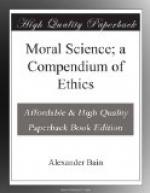It will be inferred that Brown contends warmly for the existence of Disinterested Affection, not merely as a present, but as a primitive, fact of our constitution. He does not always keep this distinct from the Moral Sentiment; he, in fact, mixes the two sentiments together in his language, a thing almost inevitable, but yet inconsistent with the advocacy of a distinct moral sentiment.
He includes among the Selfish Systems the Ethical Theory of Paley, which he reprobates in both its leading points—everlasting happiness as the motive, and the will of God as the rule. On the one point, this theory is liable to all the objections against a purely selfish system; and, on the other point, he makes the usual replies to the founding of morality on the absolute will of the Deity.
Brown next criticises the system of Adam Smith. Admitting that we have the sympathetic feeling that Smith proceeds upon, he questions its adequacy to constitute the moral sentiment, on the ground that it is not a perpetual accompaniment of our actions. There must be a certain vividness of feeling or of the display of feeling, or at least a sufficient cause of vivid feeling, to call the sympathy into action. In the numerous petty actions of life, there is an absence of any marked sympathy.
But the essential error of Smith’s system is, that it assumes the very moral feelings that it is meant to explain. If there were no antecedent moral feelings, sympathy could not afford them; it is only a mirror to reflect what is already in existence. The feelings that we sympathize with, are themselves moral feelings already; if it were not so, the reflexion of them from a thousand breasts would not give them a moral nature.
Brown thinks that Adam Smith was to some extent misled by an ambiguity in the word sympathy; a word applied not merely to the participation of other men’s feelings, but to the further and distinct fact of the approbation of those feeling’s.
Although siding in the main with Shaftesbury and Hutcheson, Brown objects to their designation Moral Sense, as expressing the innate power of moral approbation. If ‘Sense’ be interpreted merely as susceptibility, he has nothing to say, but if it mean a primary medium of perception, like the eye or the ear, he considers it a mistake. It is, in his view, an emotion, like hope, jealousy, or resentment, rising up on the presentation of a certain class of objects. He farther objects to the phrase ‘moral ideas,’ also used by Hutcheson. The moral emotions are more akin to love and hate, than to perception or judgment.
Brown gives an exposition of Practical Ethics under the usual heads: Duties to Others, to God, to Ourselves. Duties to others he classifies thus:—I.—Negative, or abstinence from injuring others in Person, Property, Affections, Character or Reputation, Knowledge (veracity), Virtue, and Tranquillity; II. Positive, or Benevolence; and III.—Duties growing out of our peculiar ties—Affinity, Friendship, Good offices received, Contract, and Citizenship.




